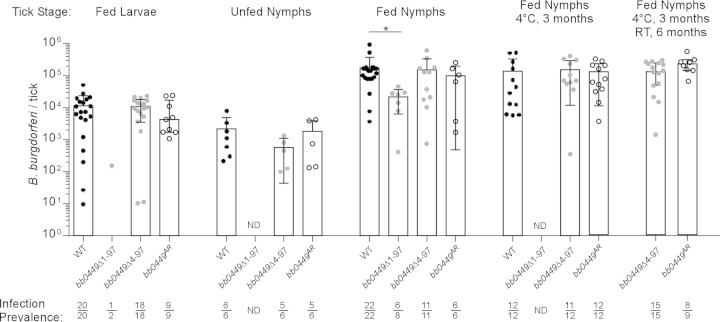FIG 6.
Spirochete loads per tick at various tick developmental stages. Ticks infected with WT, bb0449Δ1-97, bb0449Δ4-97, or bb0449AR were plated either before or 5 to 10 days after feeding on mice, to determine spirochete CFU. Data represent two independent infection experiments. WT data are pooled from the two experiments. “Fed Larvae,” larval ticks infected by feeding on infected mice to determine acquisition; “Unfed Nymphs,” infected nymphs plated before feeding to determine transstadial survival; “Fed Nymphs,” infected nymphs fed to repletion on naive mice; “Fed Nymphs 4°C, 3 months,” infected nymphs held at 4°C for 3 months before feeding on naive mice; “Fed Nymphs 4°C, 3 months RT, 6 months,” infected nymphs held for 3 months at 4°C and a further 6 months at 23°C before feeding. Bacterial loads were compared within a specific tick developmental stage with a Kruskal-Wallis test. There was no statistical difference in bacterial loads in fed larvae, unfed nymphs, fed nymphs held at 4°C for 3 months, or fed nymphs held at 4°C for 3 months and 23°C for 6 months (P = 0.67, 0.38, 0.56, and 0.15, respectively). WT-infected fed nymphs did have higher bacterial loads than bb0449Δ1-97-infected fed nymphs (P = 0.02). Points indicate values from individual ticks. Bars represent median tick bacterial loads, and error bars indicate the first and third interquartile ranges. Infection prevalence is shown as number of infected ticks divided by number of ticks plated. ND, not determined.

